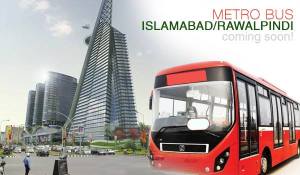The federal government has so far released about Rs 7.65 billion for the Rawalpindi-Islamabad Metro Bus Project likely to be completed in 10 months.
Ministry of Planning, Development and Reforms spokesman Asif Sheikh said that these funds were released under the federal development budget. He said that the Executive Committee of National Economic Council (ECNEC) has already accorded approval to this project.
Sheikh further said more funds will be allocated for this project in the budget for the fiscal year 2014-15. The project is likely to be completed in January-February 2015 as it will be completed in 10 months, he added.
The project is feasible and a revolutionary step to benefit hundreds of thousands of labourers, students and low paid employees travelling between the twin cities.
A minimal fare of Rs 20 will be charged from the commuters and the bus will ferry them to their respective destinations in 20 to 25 minutes.
According to official sources, the project has permission and No Objection Certificate (NOC) from the Pakistan Environment Protection Agency (PEPA).
The project has been awarded to the Rawalpindi Development Authority (RDA) while Capital Development Authority (CDA) has been asked to extend all possible cooperation in this regard.
The experts and other stakeholders have highly appreciated the project and lauded the government’s commitment to complete more such projects during its five-year tenure.
The official said that it was the vision of Prime Minister Nawaz Sharif to give every facility to the needy and poor of the country. He agreed that some trees have to be cut during execution of the project but he mentioned that there was an alternate plan of planting more than those being cut. He said that affected shop owners have also been compensated.
Rawalpindi-Islamabad Metro Bus: Rasheed submits petition against project in Supreme Court
 Awami Muslim League (AML) chief Sheikh Rasheed Ahmed submitted a petition against the Rawalpindi-Islamabad Metro Bus project in the Supreme Court on Saturday. The petition to the court stated that the project was largely driven by corruption and asked that the Supreme Court to order an investigation into the matter. The Punjab government is named as a respondent in the application.
Awami Muslim League (AML) chief Sheikh Rasheed Ahmed submitted a petition against the Rawalpindi-Islamabad Metro Bus project in the Supreme Court on Saturday. The petition to the court stated that the project was largely driven by corruption and asked that the Supreme Court to order an investigation into the matter. The Punjab government is named as a respondent in the application.
Further, the petition stated that Murree Road, which runs from Islamabad to Rawalpindi, was dug up, causing a lot of problems for traders who used that route to transport goods. The fundamental rights of people were being violated by the project, it stated further.
The request was filed under Article 184 (3) of the constitution which states: “Without prejudice to the provisions of Article 199, the Supreme Court shall, if it considers that a question of public importance with reference to the enforcement of any of the fundamental rights conferred by Chapter I of Part II is involved have the power to make an order of the nature mentioned in the said Article.”
Metro Bus Project poses threat to environment, say opposition MNAs
Muhammad Anis
Thursday, May 15, 2014
From Print Edition
Islamabad
Amid concerns from members of the opposition parties, the government on Wednesday assured the National Assembly that the concerned authorities would ensure protection to environment in the federal capital while carrying out project of Rawalpindi-Islamabad Metro Bus Project.
Minister of State for Parliamentary Affairs Shaikh Aftab Ahmad clarified that the project has been launched after getting approval from the Pakistan Environmental Protection Agency (Pak-EPA) in writing.
MNAs of the Pakistan People’s Party, including Dr. Nafisa Shah, Syed Naveed Qamar, Dr. Azra Fazal Pechuho and Shazia Marri, raised a calling attention notice to voice their concerns regarding what they termed a grave threat to natural environment of Islamabad due to the ongoing Metro Bus Project without prior approval of the Pakistan Environmental Protection Agency.
It may be pointed out here that the Pak-EPA held a public hearing of Environmental Impact Assessment (EIA) of the project on May 3 and issued a conditional NoC to the project on Tuesday (May 13).
The minister told the National Assembly that the Rawalpindi-Islamabad Metro Bus Service is a revolutionary and feasible project launched for poor commuters who cannot afford their own vehicle. He said the project will provide speedy and cheap travel facilities to the residents of the twin cities.
Terming the Lahore Metro Bus Service a success story, Shaikh Aftab Ahmad said that the project was completed in a record time of ten months and 0.7 million people were using the facility everyday.
Shaikh Aftab Ahmad said that the government would fulfil all promises in its five-year term.
Earlier, the leader of the opposition, Syed Khurshid Shah, said that the Punjab Government and the Federal Government have started the Metro Bus Project in Rawalpindi which he felt was discrimination with other provinces.
On these remarks, the minister of state for parliamentary affairs assured that such projects would also be undertaken in Khyber-Pakhtunkhwa and Sindh.
Shazia Marri wanted to ask a question as to which private company was providing iron for the project. The opposition members shouted ‘Loha, Loha’ after receiving no reply from the government benches.
Syed Khurshid Shah questioned why the government was reluctant to name the company which was providing iron for the project. “It is iron made in Pakistan, whether taken from the Ittefaq Foundry or Pakistan Steel Mills,” he said.






